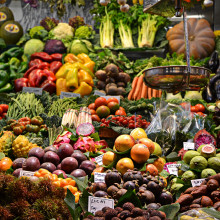QotW: When was my breath my dinner?
Greg asked, "when I exhale, my breath contains carbon atoms. How long ago were they in my food or drink?" We were hungry for answers, so Ruby Osborn asked Fred Warren from the Quadram Institute Bioscience to break it down....
In this episode

00:00 - QotW: How long ago was my breath my dinner?
QotW: How long ago was my breath my dinner?
Fred - When we eat and drink, the macronutrients (the carbohydrate, protein and fat) in our food are digested in our stomach and small intestine to produce glucose, amino acids and fatty acids, which are transported across the wall of our intestines and into the blood stream. Anything which doesn’t get digested enters into our colon, where it is fermented by the bacteria which live there to produce short chain fatty acids, which are also absorbed into our blood stream.
Ruby - So our food gets broken down into its building blocks, which then get sent around our body for a range of different uses.
Fred - After entering the blood stream, some of the nutrients are stored as fat or glycogen
Ruby - Glycogen is a big sugar which our body uses to store glucose.
Fred - A proportion is used to build and maintain our bodies, and the rest are respired for energy. During respiration, our cells convert nutrients into water and carbon dioxide, releasing the energy for us to live. The carbon dioxide is then excreted in our breath - so a proportion of the carbon from our food ends up as carbon dioxide in our breath.
Ruby - As hal C pointed out on our forum, nutrients that are stored as fat might be in our bodies for a long, long time before they eventually get used, so let’s focus on the food that goes straight into energy production. How can we measure how long it takes? How can I know if an atom of carbon I just breathed out came from lunch today, or breakfast yesterday?
Fred - For plant-based foods it is possible to label the carbon in the macronutrients, using a harmless, naturally occurring, non-radioactive isotope of carbon; carbon thirteen. We do this with colleagues at the University of Glasgow by growing the plants in a greenhouse which has labelled carbon dioxide gas pumped into it.
Ruby - Plants can do the reverse of what we do - they take in carbon dioxide, and build it up into carbohydrates. If they’re surrounded by labelled carbon dioxide, then everything they make from it will also be labelled. And if you make those plants into food, and feed it to people, you have a way to track the carbon from that specific meal.
Fred - Then we can take breath samples and use a very sensitive instrument called an isotope ratio mass spectrometer to measure the amount of labelled carbon thirteen in our breath.
Ruby - Thank you to the good people who ate in the name of science. And what is the answer to Greg’s question? How long does it take for that labelled carbon to be exhaled?
Fred - We can identify two peaks of carbon excreted in breath following eating a food. The first peak, around 2-4 hours after eating, comes from the food which is digested in the upper digestive tract being respired. The second peak, from 4-8 hours, is from short chain fatty acids produced by bacteria in the colon.




Comments
Add a comment